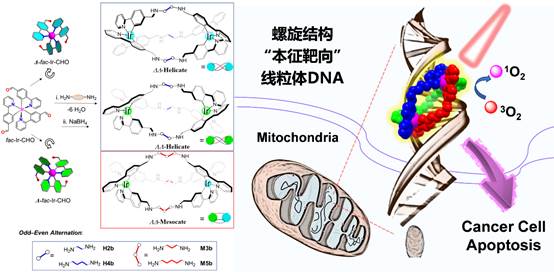
Source: School of Chemical Engineering
As one of the world’s deadliest disease, cancer seriously threatening human life and health. It is of great significance to explore newly accurate and effective means to treat cancer. Different from the traditional treatment approaches of chemotherapy and radiotherapy, photodynamic therapy (PDT) generally relies on the predominantly in situ generated 1O2 to irreversibly damage tumors when the photosensitizers are activated by light of a specific wavelength. However, the short life-time of 1O2 limits its diffusion distance in cells, which largely restricts the efficiency of PDT. The key issue includes how precisely control of the 3D geometry of the final photosensitive drugs to target biomacromolecule, such as DNA, to enhance their PDT efficacy.
Recently, Prof. Duan Chunying’s research team of State Key Laboratory of Fine Chemicals at DUT made a new progress in DNA-targeted PDT agents for cancer treatment. They designed a series of dinuclear IrIII-containing luminescent metallohelices that target mitochondrial DNA in cancer cells with tunable PDT efficacy. The metallohelices were fabricated using dynamic imine-coupling chemistry between aldehyde end-capped fac-Ir(ppy)3 handles and linear alkanediamine spacers, followed by reduction of the imine linkages. Interestingly, the length and odd–even character of the diamine alkyl linker determined the stereochemistry (helicates vs. mesocates). Compared to the helicates, the mesocates exhibit improved apoptosis-induction upon white-light irradiation. Molecular docking studies indicate that the mesocate with a proper length of diamine spacers shows stronger affinity for the minor groove of DNA. This study shows a promising approach for developing rational design and tailored IrIII-containing luminescent metallohelices with structure-inherent DNA-targeting properties for cancer therapies, and present a platform to investigate the structure–function relationship among the metallohelices and PDT efficacy.

This research entitled “Mitochondrial-DNA-Targeted IrIII-Containing Metallohelices with Tunable Photodynamic Therapy Efficacy in Cancer Cells” was published on the international authoritative journal Angew. Chem. Int. Ed., 2020, 59, 6420-6427 (). The co-first authors of the article are Li Xuezhao, a postdoctoral fellow, and Wu Jinguo, a doctoral student. And the corresponding authors are Prof. He Cheng and Prof. Duan Chunying. This work has received strong support from the Youth Program of National Natural Science Foundation of China, NSFC-Liaoning Joint Fund Project, Sino-Dutch International Exchange Project, and Dalian University of Technology.
Editor: Li Xiang